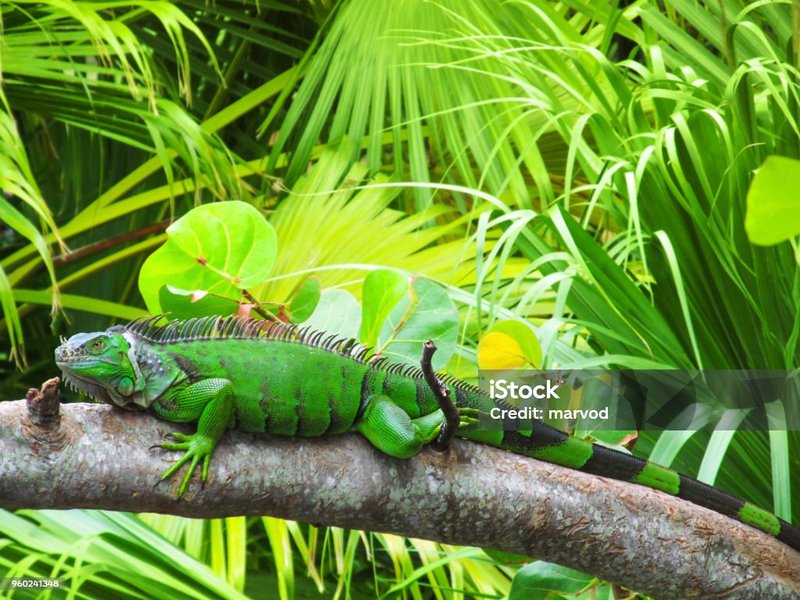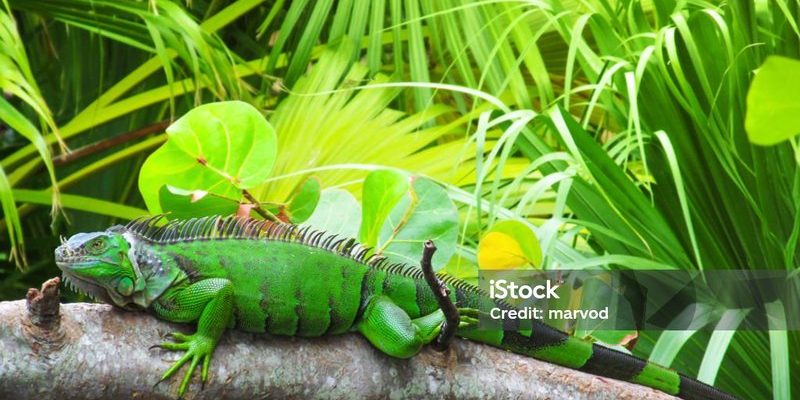
Creating an ideal habitat involves more than just providing a cage. You need to consider things like temperature, humidity, and space for climbing. Each element plays a crucial role in keeping your scaly friend happy and healthy. Brands like Exo Terra and Zoo Med offer great options for lighting, heating, and enclosures, which can help make this setup more straightforward.
Understanding Your Iguana’s Needs
Before diving into the habitat setup, let’s talk about the green iguana itself. These reptiles can reach lengths of up to six feet and live for decades when properly cared for. They’re mostly herbivorous, which means they thrive on a diet of leafy greens and vegetables. But what’s even more important is creating a habitat that mimics their natural environment.
To keep your iguana lively and healthy, you’ll need to focus on temperature gradients, humidity levels, and climbing opportunities. Believe it or not, a stressed iguana can become sick or lose its appetite. So, understanding their needs isn’t just important—it’s essential.
Choosing the Right Enclosure
When selecting an enclosure for your iguana, size is everything. A good rule of thumb is to choose a cage that’s at least four times the length of your iguana when it’s fully stretched out. This gives them enough room to move around freely. For a baby iguana, a 40-gallon tank might suffice. However, as they grow, consider upgrading to a more spacious setup—a large bird aviary or a custom-built wooden enclosure can do wonders.
Here are some things to look for:
- Height: Iguanas are excellent climbers, so ensure your enclosure has vertical space.
- Material: Go for sturdy materials that can withstand scratching and chewing.
- Ventilation: Proper airflow is critical to prevent respiratory issues.
The right enclosure not only keeps your iguana safe but also provides them with a stimulating environment.
Creating the Right Temperature Gradient
Temperature is crucial for a green iguana’s well-being. They need a gradient that allows them to bask in warmth and cool off whenever they want. Ideally, you’ll want a temperature range between 80°F and 95°F. The basking spot should be around 95°F, while the cooler areas should be about 80°F.
To achieve this, you can use heat lamps or ceramic heat emitters. Place one lamp on one end of the enclosure to create that basking zone. Here’s a simple breakdown of how to set this up:
- Heat Source: Install a UVB light that mimics the sun, providing vitamin D3 for calcium absorption.
- Thermometers: Use digital thermometers to monitor different sections of your habitat.
- Nighttime Temp: Maintain a nighttime temperature of around 70°F—no drastic drops, please!
Setting up the heating properly ensures your iguana can regulate its body temperature and stay healthy.
Maintaining Humidity Levels
Humidity is another vital aspect of your iguana’s habitat. These reptiles thrive in a humid environment, typically around 60% to 80%. Low humidity can lead to shedding problems and even respiratory issues.
To boost humidity levels, you can:
- Use a Humidifier: A small room humidifier placed near the enclosure can help.
- Regular Misting: Mist the enclosure daily to keep the humidity high.
- Water Bowl: Providing a shallow water dish for soaking can also help maintain humidity.
Monitoring the humidity with a digital hygrometer can help you keep things in check. Trust me, it’s worth the effort to avoid health issues down the road.
Adding Enrichment and Hiding Spots
Just like we enjoy a cozy nook in our homes, iguanas appreciate places to hide and climb. Adding various elements to their habitat creates a more engaging environment. Think of branches, plants, and hideaways as the furniture that makes their space feel like home.
Here are some ways to enrich their habitat:
- Branches and Logs: Use natural wood branches for climbing. Ensure they’re safe and untreated.
- Plants: Adding live or artificial plants can create a forest-like atmosphere. Just make sure they’re safe for iguanas.
- Hiding Spots: Use caves or tunnels for your iguana to retreat when they’re feeling shy.
A well-set-up enclosure isn’t just a home; it’s also a playground where your iguana can exercise and feel secure.
Choosing the Right Diet for Your Iguana
A healthy iguana starts with a balanced diet. While this section isn’t about the habitat per se, it ties into maintaining a happy and active reptile. Iguanas love fresh greens, and a varied diet keeps them interested.
Here’s what to offer:
- Leafy Greens: Collard greens, dandelion greens, and kale are fantastic choices.
- Vegetables: Squash, bell peppers, and carrots add nutritional value.
- Fruits: Offer fruits like bananas and berries sparingly as treats.
Always remember to avoid high-oxalate foods like spinach, which can hinder calcium absorption. Providing a nutritious diet supports their health, making your habitat setup truly effective.
Regular Maintenance and Cleaning
Lastly, keeping your iguana’s habitat clean is just as important as setting it up right. Bacteria can build up quickly, leading to health issues for your iguana. Here are some tips to keep things tidy:
- Daily Checks: Remove uneaten food and spot clean daily to keep waste minimal.
- Deep Cleaning: At least once a month, do a more thorough cleaning with safe, reptile-friendly disinfectants.
- Water Changes: Change the water in the bowl daily to ensure freshness.
A clean habitat not only looks better but also helps your iguana stay healthy and happy.
Creating the best habitat setup for a green iguana is a rewarding journey. Sure, it takes some time and effort, but seeing your iguana thrive in a space you’ve lovingly crafted is worth every minute. By focusing on their needs and ensuring they have a comfortable, stimulating environment, you’re setting the stage for a long, happy life together. Remember, it’s all about making your iguana feel at home, just like we all want to feel comfortable in our own spaces.

